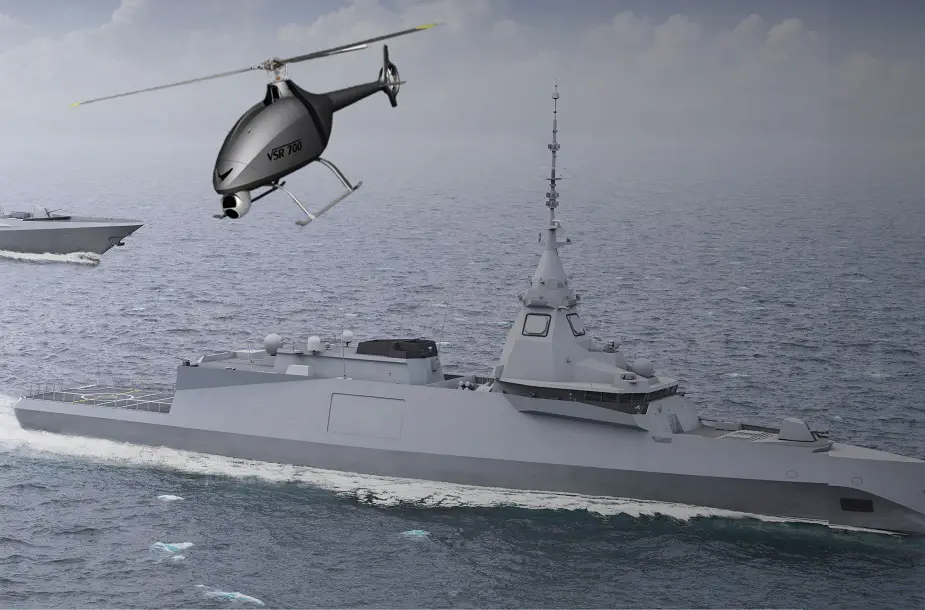Breaking news
Naval Group launches first digital frigate for French Navy.
The cutting of the first sheet of the defense and intervention frigate (FDI) took place on the Naval Group site in Lorient. The ceremony was attended by the Minister of the Armed Forces, Florence Parly, the General Delegate for Armament, Joel Barre, the Chief of Staff of the Navy, Admiral Prazuck, his Greek counterpart, Vice Admiral Nikolaos Tsounis, numerous foreign delegations, and Naval Group Chairman and CEO Hervé Guillou.
 The new FDI digital frigate of Naval Group (Picture source: Naval Group)
The new FDI digital frigate of Naval Group (Picture source: Naval Group)
FDI (Frégate de defense et d’intervention/ Defence and intervention frigate, the first digital native frigate, will benefit from an unparalleled level of digitalization thanks to a new IT architecture including two data centers, allowing for a very large capacity for data storage and analysis. She will also offer a new generation of equipment in terms of combat system, with increased capabilities such as Thales Sea Fire, the new generation four-panel fixed radar, MBDA's Aster missiles for air defense, a complete sonar suite with hull sonar and towed sonar from Thales for anti-submarine warfare.
The FDI frigate has a displacement of 4500 tons, a length of 121 meters and a width of 17.7 meters. Its maximum speed is 27 knots and it has an autonomy of 45 days with operational availability of 3500 hours per year. The frigate can accommodate 125 men and women + 28 passengers and will be able to carry at the same time a helicopter (capacity of 10 t, the actual helicopter will weigh 5t) and an Unmanned aerial vehicle (UAV), developed as part of the SDAM program with Airbus Helicopters.
New generation warships are embedding more and more computer and software-based components, not only in the Combat Systems but also in Platform Systems and equipment (Navigation System, Ship Management System). This may constitute vulnerability towards cyber-attacks, all the more so as the development of networks and computerized communication devices have provided new possibilities of intrusions from the outside.
A new bridge will allow the crew to detect any object in the close vicinity around the ship and to safely drive the ship in all situations, whether they are common (navigational, maneuvering) or threatening (asymmetric threats), by night and day. This reinforced combat system against asymmetric threats is placed in a room dedicated to threat assessment, enabling a 360° watch of the environment close to the ship and centralization of necessary actions.
FDI digital systems are natively protected. Indeed, cybersecurity on FDI is "By Design". They provide protection and defense adapted to any cyber threat the ship may be exposed to. The Cybersecurity Management System (CyMS) supervisory console has particularly intuitive man-machine interfaces. This user-friendly system offers to the operator a centralized real-time view of information on the cyber state of the platform, by gathering information from the equipment and analyzing it in detail with regard to the ship's operating modes, enabling the detection of an attack on the vessel. The software provides feedback to the operator in case of an incident. Once the corrective decision has been taken by the operator, the system makes it possible to automate and monitor the commanded actions.
The design and production of the FDI are an extension of the FREMM program and benefits from operational feedback from the French Navy, one of the most active navies on all theatres of
operations around the world. FREMM and FDI have are protected against all conventional surface and underwater threats. They can join an international force, deploy a command center in theatres of operation, and project Special Forces. Finally, these two families of frigates operate the Setis combat management system.
Belharra is the first combat ship to meet the challenges of digital technologies. A combat vessel is equipped with various systems that make extensive use of digital technologies, such as CMS, IPMS, IBNS, PMS or Communication system.
This first ship of a series of five will be delivered in 2023.




























